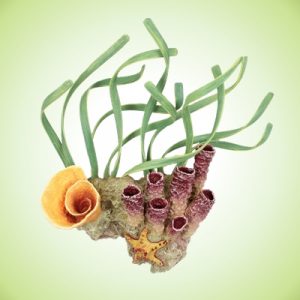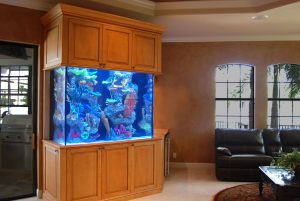When deciding to buy and aquarium, you are faced with the very important choice of a Living Reef or a Synthetic Reef. There is a tremendous amount of misinformation, misconception, and a general lack of understanding about the differences between the two scenarios. It’s important to find someone you trust to offer you the correct information so that you can make the right decision. Creative Coral Design is a great place to offer you the guidance to help you make the choice that best suits your lifestyle.
Biological Differences
 In a Living Reef aquarium there is a virtually complete ecosystem. The live rock used to build the base of the reef brings with it the bacteria necessary for biological filtration. The fish feed on both prepared foods from you, and living organisms on the reef. The fish waste products are then broken down by the “clean-up crew” (various crabs, shrimp, snails, sea cucumbers, etc.), and filtered out by various clams, sponges, anemones, and corals.
In a Living Reef aquarium there is a virtually complete ecosystem. The live rock used to build the base of the reef brings with it the bacteria necessary for biological filtration. The fish feed on both prepared foods from you, and living organisms on the reef. The fish waste products are then broken down by the “clean-up crew” (various crabs, shrimp, snails, sea cucumbers, etc.), and filtered out by various clams, sponges, anemones, and corals.
In a Synthetic Reef aquarium there is not a “complete” ecosystem. There is no live rock, therefore the surface area for the aerobic bacteria must be created. Utilizing a “wet-dry” or “trickle” filter, where water from the aquarium is trickled over high surface area media, such as the well-known “bio-balls.” and returned to the aquarium, does this. The bacteria are usually purchased in a concentrated form, and introduced into the aquarium to “seed” the biological filtration. There are no invertebrates in a synthetic reef aquarium; therefore, medications can be used to treat sick fish.
Biodiversity
While Living Reef aquariums can include a higher overall biodiversity because it contains many species of invertebrates, the fish selection is limited due to their feeding habits. In a living reef aquarium, a poorly chosen fish many constantly nibble on your ornamental (and expensive) clam(s) until they are eaten entirely, or the clam will stay closed to protect itself and end up starving to death. There are many beautiful fish that are “reef-safe.” The options depend greatly on the other fish and invertebrates you have, or would like to obtain.
A Synthetic Reef aquarium allows for a slightly larger selection of possible fish choices. There are some fish that primarily feed on live foods found in the live rock that will not survive long-term in a synthetic reef aquarium. While these fish should be avoided, there are many fish that would feed only occasionally on coral polyps or clam mantles, and they will generally do very well on prepared and frozen foods and not damage the synthetic corals. These can include many species of angelfish, triggerfish, basses, eels, lionfish, and many more.
Aesthetics
 There is a uniqueness to the hustle and bustle of a healthy, well-established Living Reef aquarium. The movement of fish, coral, and other invertebrates seems to take on an almost rhythmic flow. It takes time to establish the aquarium to get the full effect of all the diversity.
There is a uniqueness to the hustle and bustle of a healthy, well-established Living Reef aquarium. The movement of fish, coral, and other invertebrates seems to take on an almost rhythmic flow. It takes time to establish the aquarium to get the full effect of all the diversity.
A Synthetic Reef has a beauty all its own. The coral replicas are cast in a multitude of realistic, beautiful colors from real coral skeletons. One of the most attractive features of our synthetic reefs is that the base structure of the reef can be custom designed, bringing your wildest vision into reality. If you’d like to see a simulated deep-water, ridge-wall reef, they can do that. Anything is possible.
Maintenance
In a Living Reef aquarium, precise water chemistry control is crucial, because the invertebrates are sensitive to a multitude of parameters. Water testing should be performed weekly. There are a few more chemicals to add than in a fish-only scenario. Due to the addition of calcium for the corals, a purple-encrusting alga grows on everything and it’s fairly difficult to scrape off some equipment and certain areas of the aquarium. A more expensive, higher quality salt that is a true representation of the chemical percentages of true sea salt is generally recommended for the longevity of the invertebrates. More regular water changes are a must. If there is a power outage, water flow needs to be restored or an air stone added within two hours and maintained for the duration of the outage.
In a Synthetic Reef aquarium water chemistry is extremely important, but fist are much more tolerant of small variations than invertebrates are, and certain chemicals do not need to be kept at such precise levels. Supplemental chemical additions are fewer and farther between in a synthetic reef aquarium. Water flow in a synthetic reef aquarium is very important, but does not need to be as high. Since there are no invertebrates to filter feed, sponges, filter pads and canisters should be employed to help clarify the water. These will need to be inspected, cleaned and/or replaced regularly. If there is a power outage, water flow must be restored or an air stone must be added within six hours.
Operating Costs
 A Living Reef aquarium will typically cost more to operate simply in your power bill due to the intense lighting required. The cost increases due to the higher quality of salt required is relatively minimal. The cost for additional chemicals is relatively minimal, especially if a calcium reactor is employed. If you require maintenance by a maintenance company, weekly service is highly recommended. This will also add to you operating costs over a synthetic reef aquarium.
A Living Reef aquarium will typically cost more to operate simply in your power bill due to the intense lighting required. The cost increases due to the higher quality of salt required is relatively minimal. The cost for additional chemicals is relatively minimal, especially if a calcium reactor is employed. If you require maintenance by a maintenance company, weekly service is highly recommended. This will also add to you operating costs over a synthetic reef aquarium.
A Synthetic Reef aquarium will cost slightly less to operate due to the fact that there are typically fewer lights. If a maintenance company is employed, a monthly or bi-monthly service is generally recommended. The overall initial costs are about the same for a custom synthetic reef and a living reef aquarium of comparable size. The long-term cost is higher with a living reef aquarium.
Whether you choose a live or synthetic reef, adding an aquarium to your home will bring the oceans beauty inside and add a unique element that is proven to relieve stress.
Creative Coral Design can help you make the right aquarium decision for your home and lifestyle. They have a variety of options to choose from and are sure to make all your aquarium dreams come true. Visit their Shop the Pros page by clicking the button below!



